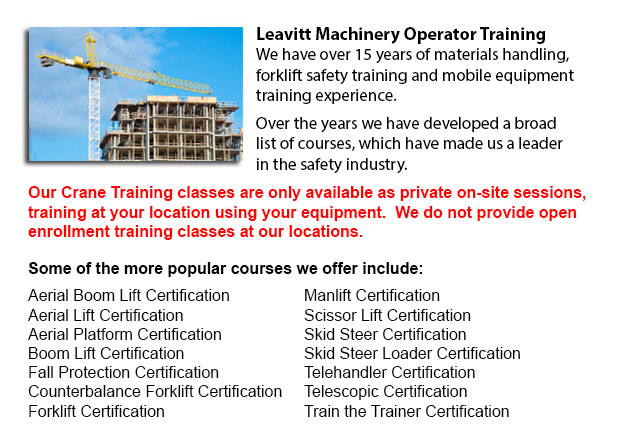
Crane Operator Classes British Columbia - For the supervisors and the operators, current and new, the crane operator training course is suitable for all. Course content includes relevant state, federal and provincial safety regulations. The training's first part includes complete in-class lessons and exam. After that is a customized hands-on session together with practical instruction and assessment.
The content of the course applies to all categories and types of overhead lifting crane machinery. The instruction will particularly focus on all aspects of crane operation which can be carried out at the workplace of the trainee. Upon completion of the course, trainees would learn how to operate specific overhead lifting devices, attachments and related components safely and efficiently.
The operator course's goal is to first identify and potentially dangerous operator habits which could develop while an individual operates an overhead crane. Costly damage to products and equipment could be prevented with proper habits. Training reduces the possibility of a workplace injury or incident happening.
The length of the course is eight hours of classroom instruction followed by a few hours of hands-on, customized, on-site training. Participants will be graded on their knowledge of training material through written tests and an assessment of their practical knowledge. The minimum acceptable score is 80 percent.
During the in-class session, participants would know applicable guidelines and legislation, causes of occurrences and damages, internal responsibility, danger awareness, design principles and basic equipment, capacity ratings/load weight calculations, pre-shift equipment inspections, safe hoisting/operating methods, kinds of hardware, equipment applications/rigging, operator/pedestrian safety, hitches and angles, turning/flipping loads safely, hand signals for operators and slingers.
The practical training and evaluation part of the course should be pre-scheduled. This customized part of the training will be held at the trainees' facility. The length of this practical training component is one to two hours. The instructor would train two operators at a time on skills like safe operation, planning the lift and right rigging practices.
After completing both the practical training and evaluation and the in-class instruction, the trainee would be tested via an exam. Each and every participant would be required to sign the safety rules. Individual wallet certificates would be given to trainees who are successful. A framed wall certificate will be provided to the company.
-
Warehouse Forklift Safety Training British Columbia
Warehouse Forklift Safety Training British Columbia - The corporation would face claims for liability when damage and injuries are sustained in an accident at the workplace. Warehouses can be a hazardous place to work for its workers, making employee... More -
Loader Operator Certification British Columbia
Loader Operator Certification British Columbia - Courses Offered For Getting Loader Operator Certification - Certification for forklifts are required to guarantee the safe operation of forklifts for those employers in industrial, warehouse or constru... More -
Crane / Overhead Crane / Self-Erect Crane / Truck Mounted Crane / Hydraulic Cranes Training in British Columbia
Bridge cranes or likewise called overhead cranes are actually a type of industrial material handling crane making use of a line and hook device that runs on a horizontal beam running along two widely separated rails. Numerous overhead cranes could be... More -
Scissor Lift License British Columbia
Scissor Lift License British Columbia - The operation of scissor lifts carries an inherent chance of danger. Whichever type of powered machine requires correct handling to prevent accidents causing injury or damage. Companies need to make certain tha... More -
Heavy Equipment Training Schools British Columbia
Heavy Equipment Training Schools British Columbia - There are a lot of heavy equipment training schools to select from. If you want to get to the best, it is important to check various aspects of the school in order to ascertain the level of educatio... More -
Telehandler Training British Columbia
Telehandler Training British Columbia - Telescopic handlers usually called telehandlers for short, are an extremely popular piece of heavy construction equipment. They are commonly utilized in the construction and agricultural trades. These machines... More -
Forklift Training Courses British Columbia
Forklift Training Courses British Columbia - When forklift operator safety training is tailored for illiteracy, training time is lessened by 50%. Forklift training certification, lift-truck operator driver safety training evaluation, and train the tr... More -
Heavy Equipment Operator Training British Columbia
Heavy Equipment Operator Training British Columbia - Heavy equipment operator training facilities which provide quality standards in the business, providing field performance work and added machinery training are highly sought after training features... More

Forklift Training British Columbia
TOLL FREE: 1-888-254-6157
forklifttrainingbritishcolumbia.com
Email Us
About Us


